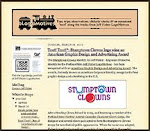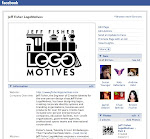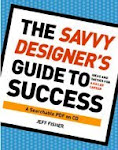The other night I was a member of a panel discussing "Harnessing the Power of Online Social Networks," hosted by Self-Employed Creative Professionals (SECP) in Portland. Others on the panel discussing the business advantages of social networking included writer Susan Rich of RichWriting Creative Services, Working Artists LLC founderAdrienne Fritze, and eMarketing Strategist Elgé Premeau. Christian Messer, of Whiplash Design, was the moderator for the evening.
I was asked to approach the subject of using online social sites from my perspective as the author of Identity Crisis!: 50 Redesigns That Transformed Stale Identities Into Successful Brands. Panel members wanted me to showcase how I had used social networking and related media to market and promote my book. In doing so, I prepared a handout for attendees with the following examples:
MySpace - MySpace drives more traffic to my web presence and blogs than any other social networking site I've used. It allows a detailed profile, image storage, blogs - which I use to post my blog headlines with links back to my own blog sites - forums and actual social networking. MySpace is much more than simply social networking for teenagers. I have eliminated most interaction not directly related to my book and my work with the posted statement: The primary purpose of this MySpace page is to discuss and promote various aspects of graphic design.
FaceBook: Facebook is probably my favorite social networking site. For me it's actually fun, in addition to providing a great opportunity for posting a detailed profile - with links back to whatever sites you wish to post, networking, image galleries, article posting capabilities, blog auto-feeds, and much more. Again, it's very effective in driving web traffic my way. A design industry editor once asked, "Isn't Facebook just for college kids?. My response was: "Have you visited Facebook lately?" It's amazing who in the design industry is making use of the resource as a marketing and promotion tool. Facebook also allows members to establish a Facebook Fan Page which offers additional opportunities to market and promote ones efforts, products or business entity.
LinkedIn: LinkedIn comes across as primarily a technical information resource for job seekers and those seeking specialized employees. The specialized questions and answers, along with the recent addition of "groups." does make it a bit more interactive. I wish the navigation wasn't so "clunky." Still, making use of the detailed profile has been a great self-promotion tool. The more information provided the more successful LinkedIn will be for the user.
biznik: biznik - Business networking that doesn't suck - is one of the most user-friendly social networking/media sites. It's easy to connect with other members and to create an actual dialog with them. The detailed profile, ability to post articles and other aspects make it a value resource for the independent business person. Local "real world" networking events are an added benefit. As in many of the examples, there are additional benefits with paid memberships.
naymz: I'm relatively new to this site. Months ago I was invited by someone I know and I did little to complete the profile until a discussion with my fellow panel members. Less than one hour of work and a great deal of traffic was coming my way - primarily due to the blogs feeds to my personal profile.
Flickr: Referring to this resource as social networking may not be the first thing that comes to a individual's mind when visiting the site. The storage and sharing of images is it's main attribute. However, the creation of personal communities, groups and the image feeds to other social sites all become part of the online networking experience.
JumpUp: This site, from the Intuit folks, is an example of another aspect of social networking - the corporate-sponsored networking resource. JumpUp creates an avenue for a detailed business profile, interacting with other business professionals, creating a blog and more. My participation online also resulted in my work and book being featured in a traveling exhibit for the company. An online radio program is in the works.
StartupNation: I've been a participant on this site for some time. My primary reason for joining was that a designer shouldn't be networking only with other designers - one needs to be interacting with business people who may become potential clients. StartupNation provides an opportunity to mingle with business people through forum participation, forum postings, a detailed profile, blogs, articles and podcasts.
Adholes: This online networking resource is primarily for the advertising professional. It's a great vehicle for networking through forum participation, posting blogs and articles, and scheduling local meetups through groups. Besides, I like the name of the group, and their tagline: "Ad industry schmoozing without the expensive restaurant tabs."
Fast Pitch: I initially made use of this site for the press release distribution capabilities. Fast Pitch now includes greater networking opportunities, blog feeds and more.
Fast Company: This is the social networking and social media presence of my favorite business magazine, Fast Company. You can network, join groups, post articles and more.
GOOD Magazine: I'm fairly new to GOOD. It's another publication that allows its readers and members to socially interact. My profile, with pertinent information posted, has drawn traffic to mt site and blogs.
Zoodango: This site recently went through a major update. I haven't yet checked out all of the features.
Ziki: The site allows you to network with others, post links, and revieve auto-feeds from blogs and Flickr. The blog feeds are especially effective in bring me a great deal of traffic.
Small Business Online Community: This offering, from Bank of America, is somewhat new and evolving. A forum allows for customer interaction, articles are posted by experts and more is offered on a regular basis.
Goodreads: This is a great social networking site for readers and authors, offering so much more than just the opportunity to connect with others around the world.As the author of Identity Crisis!: 50 redesigns that transformed stale identities into successful brands, Goodreads provides yet another marketing tool for my book with my own author's page. Authors can post a detailed biography, make note of upcoming book-related events, share writings or book excerpts, participate in discussion groups, and promote their own books.
This is far from a complete list of the sources available for social networking and social media. As mentioned earlier, these are just the resources I put into play in marketing and promoting my book, Identity Crisis!. As you can see, from each page example, I have taken the opportunity to establish a somewhat consistent look in the content and imagery used in each profile. The photo of me is the same in many, my logo is an identifying mark for most, the same book cover image is featured, mentions of the book are always included, and website, or blog, addresses are used with consistency.
Still, it the examples presented should give many people ideas of where they might look for added marketing opportunities.
For a look at portfolio sites check out my earlier piece Marketing logo design efforts with online resources.
© 2008 Jeff Fisher LogoMotives



































